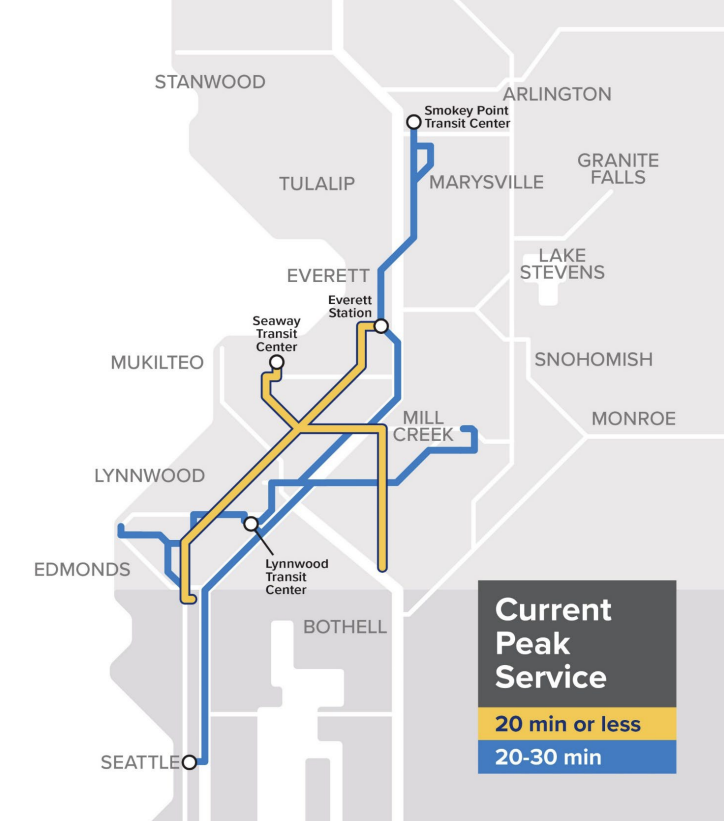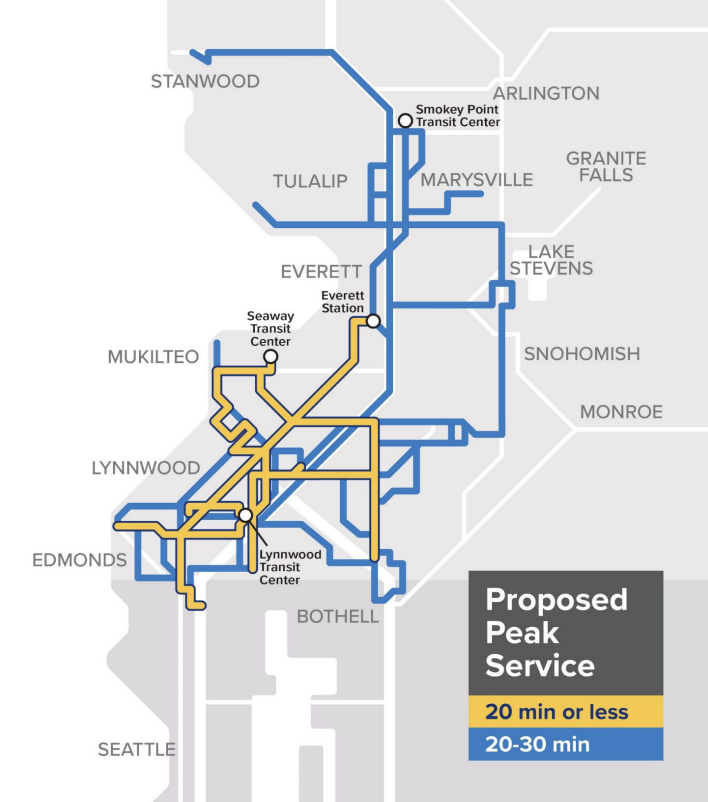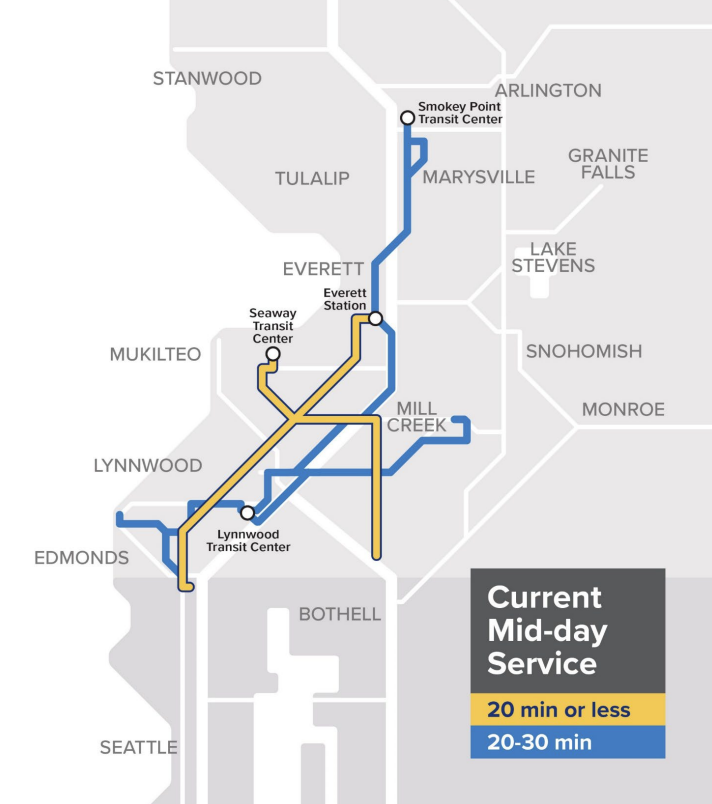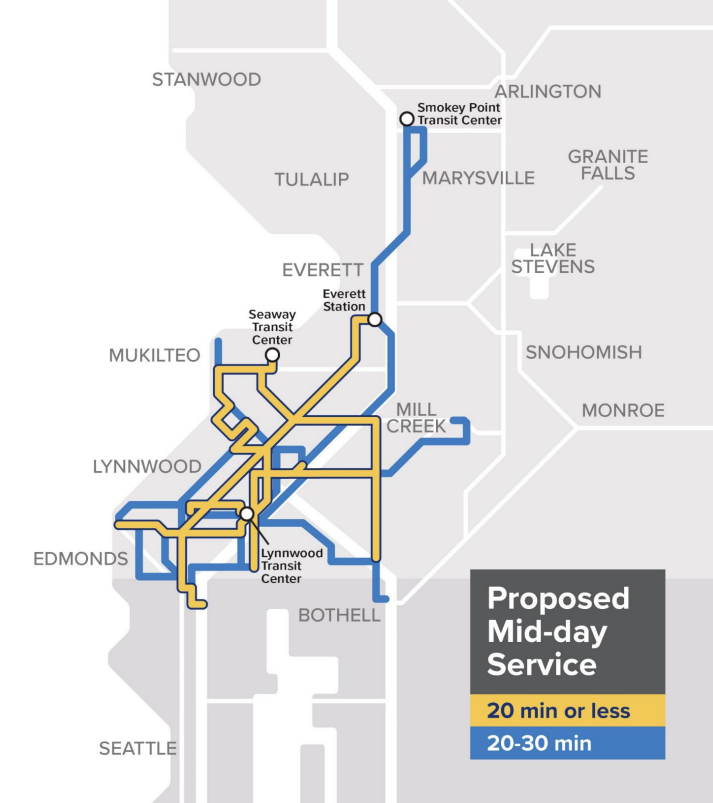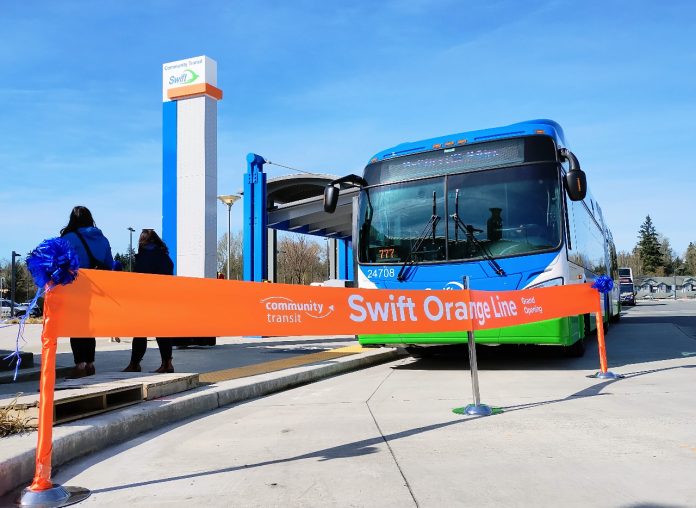
Community Transit officially launched the Swift Orange Line Saturday, its third rapid bus line connecting McCollum Park and Ride in South Everett to the back door of Edmonds at Edmonds College. The new line is being rightfully touted for providing more frequent connections to Lynnwood’s impending light rail station from more of Snohomish County, but the line is a big leap forward for the overall Community Transit network and the agency’s service expansion goals.
The Orange Line’s launch is the first major opening of a new transit line region-wide so far in 2024. At the ribbon-cutting Saturday, Community Transit CEO Ric Ilgenfritz described watching the first Orange Line bus roll out of its bus base at 5:15am early that morning. “As that first bus pulled out of the yard, it’s setting in motion a series of changes that are going to ripple across this region the entire year,” Ilgenfritz said. “2024 is a huge year for transit in the Pacific Northwest and the Puget Sound region, and we are so proud to be getting it started here today.”
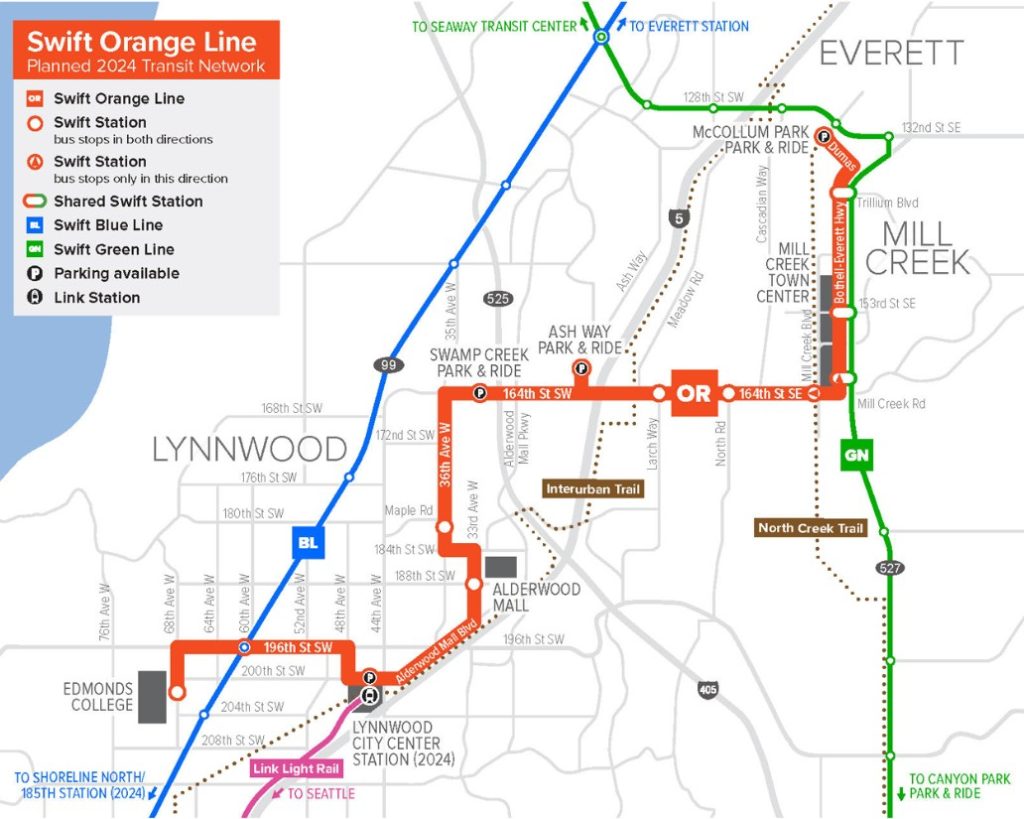
The schedule for the new Orange Line calls for buses every 10 minutes throughout the day on weekdays, dropping to 15 minute service mid-day on Saturdays and 20 minute service on Sundays and later in the evening every day. Like the existing Swift Blue and Green Lines, the route features off-board payment, all-door boarding, and real-time arrival screens at stations letting riders know how quickly the next bus is arriving. Coaches are designed to handle crowds, with designated areas on board for bicycles for quicker loading and unloading.
Some coaches do have on-board arrival screens showing riders where they are along the route and what the upcoming stops are, but they have not been fully deployed across the Community Transit fleet yet.
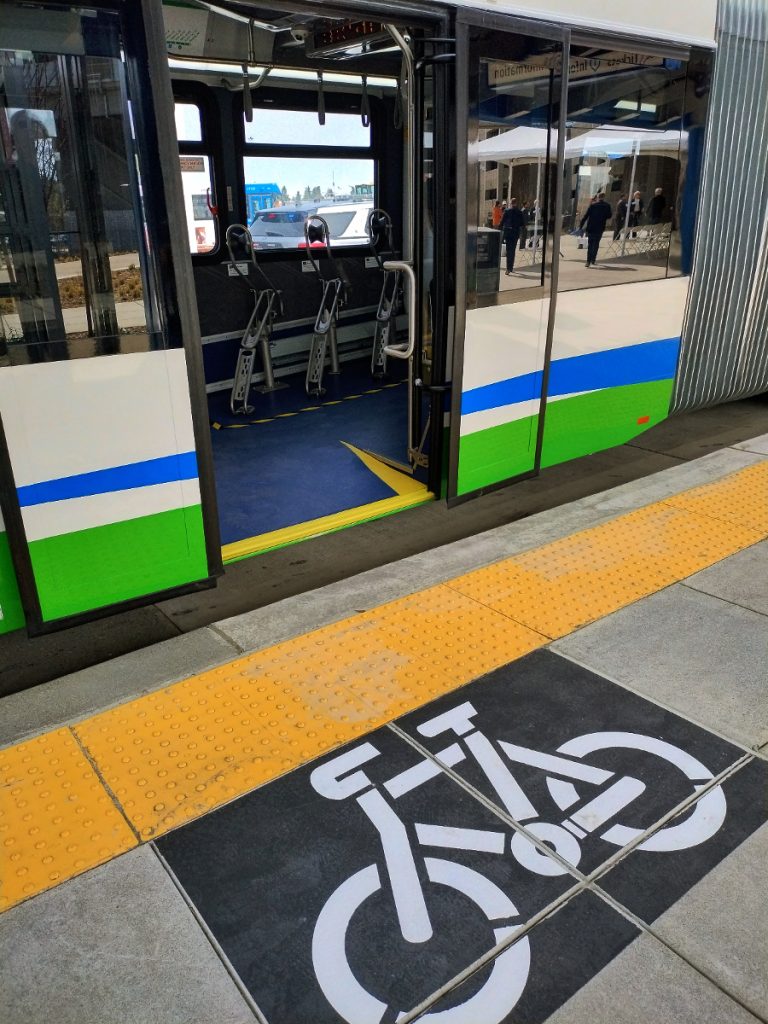
What the Orange Line doesn’t feature much of is dedicated transit lanes, with the business access and transit (BAT) lanes along newly remade 196th St SW in Lynnwood one of the only places along the route where buses have been given significant space to bypass general purpose traffic. The primary benefit for riders is the ease of boarding and the increased frequency on the route.
Community Transit’s two existing Swift lines carried over one-third of the transit trips the agency saw in 2023, as total ridership increased by 23% compared to 2022 levels, and the Orange line’s arrival is well-timed to provide direct connections to Lynnwood’s light rail station, set to open sometime this fall.
“Why are the Swift lines so popular? Because people don’t have to plan their day around a schedule,” City of Snohomish Councilmember and current Community Transit board chair Tom Merrill said at Saturday’s groundbreaking. “So services are reliable and frequent with arrivals every 10 minutes during peak commute times, and these are very similar qualities to the popular light rail. And speaking of light rail, we’re eagerly looking forward to its arrival here in Lynnwood later this year, where it will connect with three Swift services, and with that comes opportunity.”
Planning for the Orange Line began in earnest in 2018, and the project had its groundbreaking in 2022. The line received around 80% of its $83 million budget covered by federal dollars, including $37 million in Federal Transit Administration (FTA) Small Starts funding, and $6.5 million in American Rescue Plan stimulus funds.
Across Washington State, bus rapid transit lines have been varying widely in costs per mile, but the Orange Line ranks in the middle of the pack, coming in at $7.3 million per mile. That’s compared to $5 million per mile for Vancouver’s Mill Plain Vine, which opened last year, and $9.4 million for the planned RapidRide I Line between Renton and Auburn, being built by King County Metro. Spokane’s City Line, built by the Spokane Transit Authority, came in nearly twice the cost of the Orange Line per mile, with an $82 million price tag for a route that runs less than six miles.
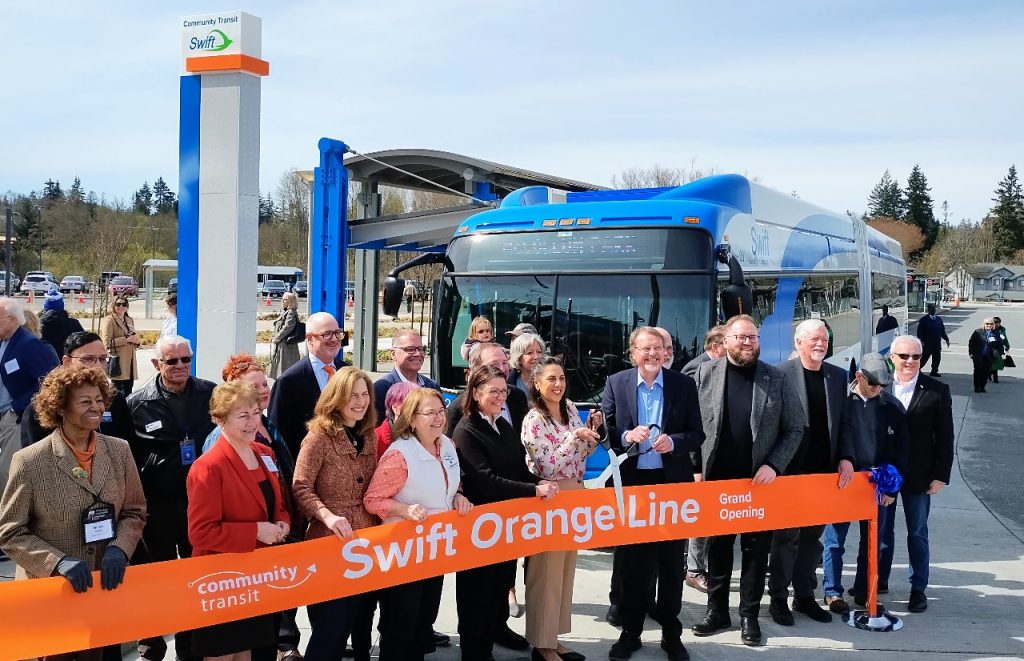
As elected officials, including three members of Washington’s congressional delegation, celebrated the Orange Line’s opening Saturday, they talked up the role that President Biden’s 2021 Infrastructure Investment and Jobs Act (IIJA) is playing in advancing projects like this one.
That law did reauthorize the funding streams that make FTA programs like the Small Starts grants possible, but an analysis released earlier this year by Transportation for America found that over a quarter of the IIJA’s formula dollars, which aren’t handed out via competitive grants, have gone to road expansion projects set to make transit less competitive and increase overall emissions and car dependency.
A big first step toward new Community Transit network
The Orange Line’s arrival is an early piece in the overall evolution of Community Transit’s network, most of which is set to fall into place with the start of light rail service to Lynnwood sometime this fall. With riders who would normally be using Community Transit buses to head to downtown Seattle instead being directed to light rail — or Sound Transit express buses to alleviate overcrowding — the agency will be able to reinvest the hours those buses had been on the road back into the network.
Ultimately, the countywide network that Community Transit’s board approved early last year envisions a 32% increase in overall service compared to what the agency was operating last week prior to the launch of the Orange line, but it may take several years for the entire network to fully reach promised frequencies everywhere. With the launch of light rail this fall, the structure of the network will go into place.
The proposed peak network is set to expand access to 76% more Snohomish County residents, and provide access to 50% more jobs.
The mid-day network, the mark of a truly frequent transit network, includes less expansive coverage than the new peak network but will see many more routes get to 20 minute service or less, getting closer to the point where you don’t have to rely on a schedule. That mid-day network expands access to 68% more residents and 40% more jobs.
What’s next for the Swift network?
Quick on the heels of the Orange Line opening will be another ribbon-cutting for the Swift network: the extension of the existing Blue Line south from Aurora Transit Center to Shoreline’s northern light rail station at 185th Street later this year. That will bring two direct connections to the Swift network by the time light rail extends north of Northgate Station.
After that are a quiet few years for the Swift network. The next line planned to open will be the Gold Line, running from Everett Station to Arlington’s Smokey Point Transit Center, set to launch sometime between 2027 and 2029. The Gold Line, notably, would be the first rapid bus line planned in the Puget Sound region outside of the Sound Transit taxing district.

After that, Community Transit is planning an extension of the existing Green Line to launch sometime between 2028 and 2031. That project is heavily dependent on work that the City of Bothell is doing to change Bothell Way NE, which isn’t currently able to handle buses very well. Once that street rebuild is completed, Bothell Way NE will be wide enough for buses to be able to get to UW Bothell, though they aren’t currently set to have their own dedicated lanes. With that connection, the Swift network will have its second tie-in with Sound Transit’s I-405 Stride BRT network, along with a planned station in Lynnwood.
All in all, the launch of the Orange Line is worthy of celebration and sets transit in Snohomish County up for positive changes for years to come.
Ryan Packer has been writing for The Urbanist since 2015, and currently reports full-time as Contributing Editor. Their beats are transportation, land use, public space, traffic safety, and obscure community meetings. Packer has also reported for other regional outlets including Capitol Hill Seattle, BikePortland, Seattle Met, and PubliCola. They live in the Capitol Hill neighborhood of Seattle.


